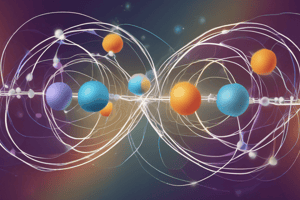Podcast
Questions and Answers
What is the primary reason for the periodic recurrence of elemental properties in the periodic table?
What is the primary reason for the periodic recurrence of elemental properties in the periodic table?
Which group of elements is characterized by having one valence electron?
Which group of elements is characterized by having one valence electron?
What trend is observed in atomic radius across a period in the periodic table?
What trend is observed in atomic radius across a period in the periodic table?
Which of the following statements about ionization energy is correct?
Which of the following statements about ionization energy is correct?
Signup and view all the answers
How does electronegativity change as you move down a group in the periodic table?
How does electronegativity change as you move down a group in the periodic table?
Signup and view all the answers
Which group consists of highly reactive nonmetals?
Which group consists of highly reactive nonmetals?
Signup and view all the answers
What common property do elements in the same group of the periodic table share?
What common property do elements in the same group of the periodic table share?
Signup and view all the answers
Which of the following elements has the highest electronegativity?
Which of the following elements has the highest electronegativity?
Signup and view all the answers
What is the role of valence electrons in the reactivity of an element?
What is the role of valence electrons in the reactivity of an element?
Signup and view all the answers
Which of the following correctly describes Period 2 in the periodic table?
Which of the following correctly describes Period 2 in the periodic table?
Signup and view all the answers
What is the role of valence electrons in atoms?
What is the role of valence electrons in atoms?
Signup and view all the answers
Which statement about the modern periodic table is true?
Which statement about the modern periodic table is true?
Signup and view all the answers
How can you determine the number of valence electrons in an element?
How can you determine the number of valence electrons in an element?
Signup and view all the answers
What does the electron configuration of an atom represent?
What does the electron configuration of an atom represent?
Signup and view all the answers
Which of the following correctly identifies the number of valence electrons for Group 1 elements?
Which of the following correctly identifies the number of valence electrons for Group 1 elements?
Signup and view all the answers
What components make up an atom's nucleus?
What components make up an atom's nucleus?
Signup and view all the answers
Why do elements in the same group of the periodic table exhibit similar chemical properties?
Why do elements in the same group of the periodic table exhibit similar chemical properties?
Signup and view all the answers
An atom has the electron configuration of 1s² 2s² 2p⁶. How many valence electrons does it have?
An atom has the electron configuration of 1s² 2s² 2p⁶. How many valence electrons does it have?
Signup and view all the answers
The periodic law states that the properties of elements are a function of what?
The periodic law states that the properties of elements are a function of what?
Signup and view all the answers
Which is NOT a characteristic of the valence electrons?
Which is NOT a characteristic of the valence electrons?
Signup and view all the answers
The nucleus of an atom consists of protons, neutrons, and electrons.
The nucleus of an atom consists of protons, neutrons, and electrons.
Signup and view all the answers
Valence electrons determine an element's chemical reactivity and bonding behavior.
Valence electrons determine an element's chemical reactivity and bonding behavior.
Signup and view all the answers
Elements in the modern periodic table are arranged based on their mass number.
Elements in the modern periodic table are arranged based on their mass number.
Signup and view all the answers
The electron configuration of an atom can help predict its chemical properties.
The electron configuration of an atom can help predict its chemical properties.
Signup and view all the answers
Group 17 elements, also known as halogens, have 8 valence electrons.
Group 17 elements, also known as halogens, have 8 valence electrons.
Signup and view all the answers
Elements in Group 17 of the periodic table have five valence electrons.
Elements in Group 17 of the periodic table have five valence electrons.
Signup and view all the answers
The atomic radius of an element generally increases as you move from left to right across a period in the periodic table.
The atomic radius of an element generally increases as you move from left to right across a period in the periodic table.
Signup and view all the answers
Ionization energy tends to increase as you move down a group in the periodic table.
Ionization energy tends to increase as you move down a group in the periodic table.
Signup and view all the answers
There are 7 groups in the periodic table, each with distinct elemental properties.
There are 7 groups in the periodic table, each with distinct elemental properties.
Signup and view all the answers
Elements with high electronegativity, like fluorine, tend to strongly attract electrons in a bond.
Elements with high electronegativity, like fluorine, tend to strongly attract electrons in a bond.
Signup and view all the answers
Study Notes
Overview of Chemistry
- Chemistry examines matter and its transformations, focusing on atomic interactions to form compounds.
- Valence electrons are pivotal in chemical bonding and determine elements' reactivity and bonding tendencies.
The Basics of Atoms
- Atoms are the fundamental units of matter, containing a nucleus of protons and neutrons, with orbiting electrons.
- The atomic number is defined by the number of protons, which also identifies the element.
- Electrons are structured in energy levels or shells around the nucleus.
What Are Valence Electrons?
- Valence electrons reside in the outermost shell of an atom and are essential for bond formation.
- Electron configuration indicates the arrangement of electrons; for example, carbon's configuration is 1s² 2s² 2p², identifying the valence electrons as 2s² 2p².
- Main-group elements' valence electron count corresponds to their group number in the periodic table.
The Modern Periodic Table
- The periodic table organizes elements by ascending atomic number and groups them by similar chemical properties.
- Periodic law illustrates that element properties are periodic functions of their atomic numbers, leading to recurring similarities.
- The layout features periods (horizontal rows) and groups (vertical columns), with elements in the same group sharing chemical properties and valence electron quantities.
Groups and Periods
- There are 18 groups, each sharing characteristics due to analogous electron configurations:
- Group 1 (Alkali Metals) consists of highly reactive metals with one valence electron.
- Group 17 (Halogens) comprises reactive nonmetals with seven valence electrons.
- The table includes 7 periods where elements have identical electron shell counts:
- For example, Period 2 consists of lithium (Li) and neon (Ne), featuring electrons in the first and second shells, respectively.
Electron Configuration and Periodic Trends
- Atomic radius decreases from left to right across a period and increases from top to bottom of a group, influenced by nuclear charge.
- Ionization energy rises across a period and drops down a group, with elements having fewer valence electrons exhibiting lower ionization energies.
- Electronegativity measures an atom's electron-attracting ability, increasing across periods and decreasing down groups; fluorine has the highest electronegativity.
Practical Applications
- Knowledge of valence electrons and the periodic table aids in predicting chemical reactivity and properties.
- Example: Sodium (Na) with one valence electron and chlorine (Cl) with seven readily form sodium chloride (NaCl) through ionic bonding.
Conclusion
- Understanding valence electrons and periodic table trends is essential for grasping chemical behavior and predicting elemental interactions.
- This foundation is crucial for exploring complex chemical concepts and reactions.
Overview of Chemistry
- Chemistry examines matter and its transformations, focusing on atomic interactions to form compounds.
- Valence electrons are pivotal in chemical bonding and determine elements' reactivity and bonding tendencies.
The Basics of Atoms
- Atoms are the fundamental units of matter, containing a nucleus of protons and neutrons, with orbiting electrons.
- The atomic number is defined by the number of protons, which also identifies the element.
- Electrons are structured in energy levels or shells around the nucleus.
What Are Valence Electrons?
- Valence electrons reside in the outermost shell of an atom and are essential for bond formation.
- Electron configuration indicates the arrangement of electrons; for example, carbon's configuration is 1s² 2s² 2p², identifying the valence electrons as 2s² 2p².
- Main-group elements' valence electron count corresponds to their group number in the periodic table.
The Modern Periodic Table
- The periodic table organizes elements by ascending atomic number and groups them by similar chemical properties.
- Periodic law illustrates that element properties are periodic functions of their atomic numbers, leading to recurring similarities.
- The layout features periods (horizontal rows) and groups (vertical columns), with elements in the same group sharing chemical properties and valence electron quantities.
Groups and Periods
- There are 18 groups, each sharing characteristics due to analogous electron configurations:
- Group 1 (Alkali Metals) consists of highly reactive metals with one valence electron.
- Group 17 (Halogens) comprises reactive nonmetals with seven valence electrons.
- The table includes 7 periods where elements have identical electron shell counts:
- For example, Period 2 consists of lithium (Li) and neon (Ne), featuring electrons in the first and second shells, respectively.
Electron Configuration and Periodic Trends
- Atomic radius decreases from left to right across a period and increases from top to bottom of a group, influenced by nuclear charge.
- Ionization energy rises across a period and drops down a group, with elements having fewer valence electrons exhibiting lower ionization energies.
- Electronegativity measures an atom's electron-attracting ability, increasing across periods and decreasing down groups; fluorine has the highest electronegativity.
Practical Applications
- Knowledge of valence electrons and the periodic table aids in predicting chemical reactivity and properties.
- Example: Sodium (Na) with one valence electron and chlorine (Cl) with seven readily form sodium chloride (NaCl) through ionic bonding.
Conclusion
- Understanding valence electrons and periodic table trends is essential for grasping chemical behavior and predicting elemental interactions.
- This foundation is crucial for exploring complex chemical concepts and reactions.
Studying That Suits You
Use AI to generate personalized quizzes and flashcards to suit your learning preferences.
Description
Explore the fundamental concepts of atoms, their structures, and how they interact to form compounds. This quiz covers the role of valence electrons and the organization of the periodic table, providing a solid foundation for understanding chemistry.




